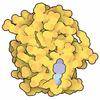| 登録情報 | データベース: PDB / ID: 3kmr
|
|---|
| タイトル | Crystal structure of RARalpha ligand binding domain in complex with an agonist ligand (Am580) and a coactivator fragment |
|---|
 要素 要素 | - Nuclear receptor coactivator 1
- Retinoic acid receptor alpha
|
|---|
 キーワード キーワード | TRANSCRIPTION / nuclear receptor transcription factor ligand binding domain / DNA-binding / Metal-binding / Nucleus / Phosphoprotein / Proto-oncogene / Receptor / Transcription regulation / Zinc-finger / Activator / Acyltransferase / Isopeptide bond / Transferase |
|---|
| 機能・相同性 |  機能・相同性情報 機能・相同性情報
Sertoli cell fate commitment / positive regulation of binding / trachea cartilage development / glandular epithelial cell development / ventricular cardiac muscle cell differentiation / chondroblast differentiation / embryonic camera-type eye development / protein kinase B binding / growth plate cartilage development / negative regulation of granulocyte differentiation ...Sertoli cell fate commitment / positive regulation of binding / trachea cartilage development / glandular epithelial cell development / ventricular cardiac muscle cell differentiation / chondroblast differentiation / embryonic camera-type eye development / protein kinase B binding / growth plate cartilage development / negative regulation of granulocyte differentiation / prostate gland development / positive regulation of T-helper 2 cell differentiation / retinoic acid-responsive element binding / negative regulation of cartilage development / regulation of hematopoietic progenitor cell differentiation / positive regulation of interleukin-13 production / positive regulation of interleukin-5 production / retinoic acid binding / outflow tract septum morphogenesis / labyrinthine layer morphogenesis / positive regulation of transcription from RNA polymerase II promoter by galactose / regulation of thyroid hormone receptor signaling pathway / positive regulation of female receptivity / TGFBR3 expression / response to vitamin A / heterocyclic compound binding / limb development / apoptotic cell clearance / ureteric bud development / regulation of myelination / Signaling by Retinoic Acid / DNA-binding transcription repressor activity / NR1H2 & NR1H3 regulate gene expression to control bile acid homeostasis / protein kinase A binding / male mating behavior / hypothalamus development / positive regulation of interleukin-4 production / face development / germ cell development / alpha-actinin binding / negative regulation of type II interferon production / cellular response to Thyroglobulin triiodothyronine / Synthesis of bile acids and bile salts / progesterone receptor signaling pathway / negative regulation of tumor necrosis factor production / cellular response to estrogen stimulus / Synthesis of bile acids and bile salts via 27-hydroxycholesterol / Endogenous sterols / Synthesis of bile acids and bile salts via 7alpha-hydroxycholesterol / response to retinoic acid / estrous cycle / nuclear retinoid X receptor binding / histone acetyltransferase activity / cellular response to hormone stimulus / Recycling of bile acids and salts / Transcriptional regulation of brown and beige adipocyte differentiation by EBF2 / histone acetyltransferase / retinoic acid receptor signaling pathway / NR1H3 & NR1H2 regulate gene expression linked to cholesterol transport and efflux / estrogen receptor signaling pathway / positive regulation of cell cycle / cellular response to retinoic acid / lactation / : / positive regulation of adipose tissue development / Regulation of lipid metabolism by PPARalpha / response to cytokine / peroxisome proliferator activated receptor signaling pathway / positive regulation of neuron differentiation / regulation of cellular response to insulin stimulus / BMAL1:CLOCK,NPAS2 activates circadian expression / SUMOylation of transcription cofactors / Activation of gene expression by SREBF (SREBP) / response to progesterone / negative regulation of miRNA transcription / mRNA regulatory element binding translation repressor activity / cerebellum development / nuclear estrogen receptor binding / nuclear receptor binding / neural tube closure / RNA polymerase II transcription regulatory region sequence-specific DNA binding / hippocampus development / SUMOylation of intracellular receptors / mRNA transcription by RNA polymerase II / Heme signaling / liver development / female pregnancy / Transcriptional activation of mitochondrial biogenesis / PPARA activates gene expression / Cytoprotection by HMOX1 / cerebral cortex development / regulation of synaptic plasticity / chromatin DNA binding / mRNA 5'-UTR binding / Nuclear Receptor transcription pathway / Transcriptional regulation of white adipocyte differentiation / transcription coactivator binding / RNA polymerase II transcription regulator complex / multicellular organism growth / histone deacetylase binding類似検索 - 分子機能 : / : / Retinoic acid receptor / Nuclear receptor coactivator 1 / Nuclear receptor coactivator, DUF1518 / Nuclear receptor coactivator, Ncoa-type, interlocking / Nuclear receptor coactivator, Ncoa-type, interlocking domain superfamily / Nuclear receptor coactivator, DUF1518 / Nuclear receptor coactivator / DUF1518 ...: / : / Retinoic acid receptor / Nuclear receptor coactivator 1 / Nuclear receptor coactivator, DUF1518 / Nuclear receptor coactivator, Ncoa-type, interlocking / Nuclear receptor coactivator, Ncoa-type, interlocking domain superfamily / Nuclear receptor coactivator, DUF1518 / Nuclear receptor coactivator / DUF1518 / Nuclear receptor coactivator, receptor-binding domain / Nuclear receptor coactivator / : / Steroid receptor coactivator / Unstructured region on nuclear receptor coactivator protein / Nuclear receptor coactivators bHLH domain / PAS domain / Nuclear receptor coactivator, interlocking / helix loop helix domain / Myc-type, basic helix-loop-helix (bHLH) domain / Myc-type, basic helix-loop-helix (bHLH) domain profile. / Helix-loop-helix DNA-binding domain superfamily / PAS fold / PAS fold / PAS domain / PAS repeat profile. / PAS domain / Retinoid X Receptor / Retinoid X Receptor / PAS domain superfamily / Nuclear hormone receptor / Nuclear hormones receptors DNA-binding region signature. / Zinc finger, nuclear hormone receptor-type / Double treble clef zinc finger, C4 type / Nuclear hormone receptors DNA-binding domain profile. / c4 zinc finger in nuclear hormone receptors / Nuclear hormone receptor, ligand-binding domain / Nuclear hormone receptor-like domain superfamily / Ligand-binding domain of nuclear hormone receptor / Nuclear receptor (NR) ligand-binding (LBD) domain profile. / Ligand binding domain of hormone receptors / Zinc finger, NHR/GATA-type / Orthogonal Bundle / Mainly Alpha類似検索 - ドメイン・相同性 Chem-EQN / Retinoic acid receptor alpha / Nuclear receptor coactivator 1類似検索 - 構成要素 |
|---|
| 生物種 |  Homo sapiens (ヒト) Homo sapiens (ヒト) |
|---|
| 手法 |  X線回折 / X線回折 /  シンクロトロン / シンクロトロン /  分子置換 / 解像度: 1.8 Å 分子置換 / 解像度: 1.8 Å |
|---|
 データ登録者 データ登録者 | Bourguet, W. / Teyssier, C. |
|---|
 引用 引用 |  ジャーナル: Nat.Struct.Mol.Biol. / 年: 2010 ジャーナル: Nat.Struct.Mol.Biol. / 年: 2010
タイトル: A unique secondary-structure switch controls constitutive gene repression by retinoic acid receptor.
著者: le Maire, A. / Teyssier, C. / Erb, C. / Grimaldi, M. / Alvarez, S. / de Lera, A.R. / Balaguer, P. / Gronemeyer, H. / Royer, C.A. / Germain, P. / Bourguet, W. |
|---|
| 履歴 | | 登録 | 2009年11月11日 | 登録サイト: RCSB / 処理サイト: RCSB |
|---|
| 改定 1.0 | 2010年6月2日 | Provider: repository / タイプ: Initial release |
|---|
| 改定 1.1 | 2011年7月13日 | Group: Version format compliance |
|---|
| 改定 1.2 | 2023年9月6日 | Group: Data collection / Database references ...Data collection / Database references / Derived calculations / Refinement description
カテゴリ: chem_comp_atom / chem_comp_bond ...chem_comp_atom / chem_comp_bond / database_2 / pdbx_initial_refinement_model / struct_ref_seq_dif / struct_site
Item: _database_2.pdbx_DOI / _database_2.pdbx_database_accession ..._database_2.pdbx_DOI / _database_2.pdbx_database_accession / _struct_ref_seq_dif.details / _struct_site.pdbx_auth_asym_id / _struct_site.pdbx_auth_comp_id / _struct_site.pdbx_auth_seq_id |
|---|
|
|---|
 データを開く
データを開く 基本情報
基本情報 要素
要素 キーワード
キーワード 機能・相同性情報
機能・相同性情報 Homo sapiens (ヒト)
Homo sapiens (ヒト) X線回折 /
X線回折 /  シンクロトロン /
シンクロトロン /  分子置換 / 解像度: 1.8 Å
分子置換 / 解像度: 1.8 Å  データ登録者
データ登録者 引用
引用 ジャーナル: Nat.Struct.Mol.Biol. / 年: 2010
ジャーナル: Nat.Struct.Mol.Biol. / 年: 2010 構造の表示
構造の表示 Molmil
Molmil Jmol/JSmol
Jmol/JSmol ダウンロードとリンク
ダウンロードとリンク ダウンロード
ダウンロード 3kmr.cif.gz
3kmr.cif.gz PDBx/mmCIF形式
PDBx/mmCIF形式 pdb3kmr.ent.gz
pdb3kmr.ent.gz PDB形式
PDB形式 3kmr.json.gz
3kmr.json.gz PDBx/mmJSON形式
PDBx/mmJSON形式 その他のダウンロード
その他のダウンロード 3kmr_validation.pdf.gz
3kmr_validation.pdf.gz wwPDB検証レポート
wwPDB検証レポート 3kmr_full_validation.pdf.gz
3kmr_full_validation.pdf.gz 3kmr_validation.xml.gz
3kmr_validation.xml.gz 3kmr_validation.cif.gz
3kmr_validation.cif.gz https://data.pdbj.org/pub/pdb/validation_reports/km/3kmr
https://data.pdbj.org/pub/pdb/validation_reports/km/3kmr ftp://data.pdbj.org/pub/pdb/validation_reports/km/3kmr
ftp://data.pdbj.org/pub/pdb/validation_reports/km/3kmr リンク
リンク 集合体
集合体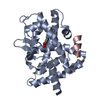
 要素
要素 Homo sapiens (ヒト) / 遺伝子: NR1B1, RARA / プラスミド: pET15b / 発現宿主:
Homo sapiens (ヒト) / 遺伝子: NR1B1, RARA / プラスミド: pET15b / 発現宿主: 
 X線回折 / 使用した結晶の数: 1
X線回折 / 使用した結晶の数: 1  試料調製
試料調製 シンクロトロン / サイト:
シンクロトロン / サイト:  ESRF
ESRF  / ビームライン: ID14-2 / 波長: 0.9395 Å
/ ビームライン: ID14-2 / 波長: 0.9395 Å 解析
解析 分子置換
分子置換 ムービー
ムービー コントローラー
コントローラー





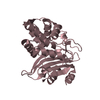
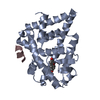
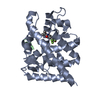

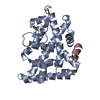
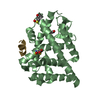
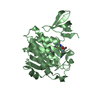

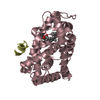
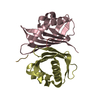
 PDBj
PDBj



